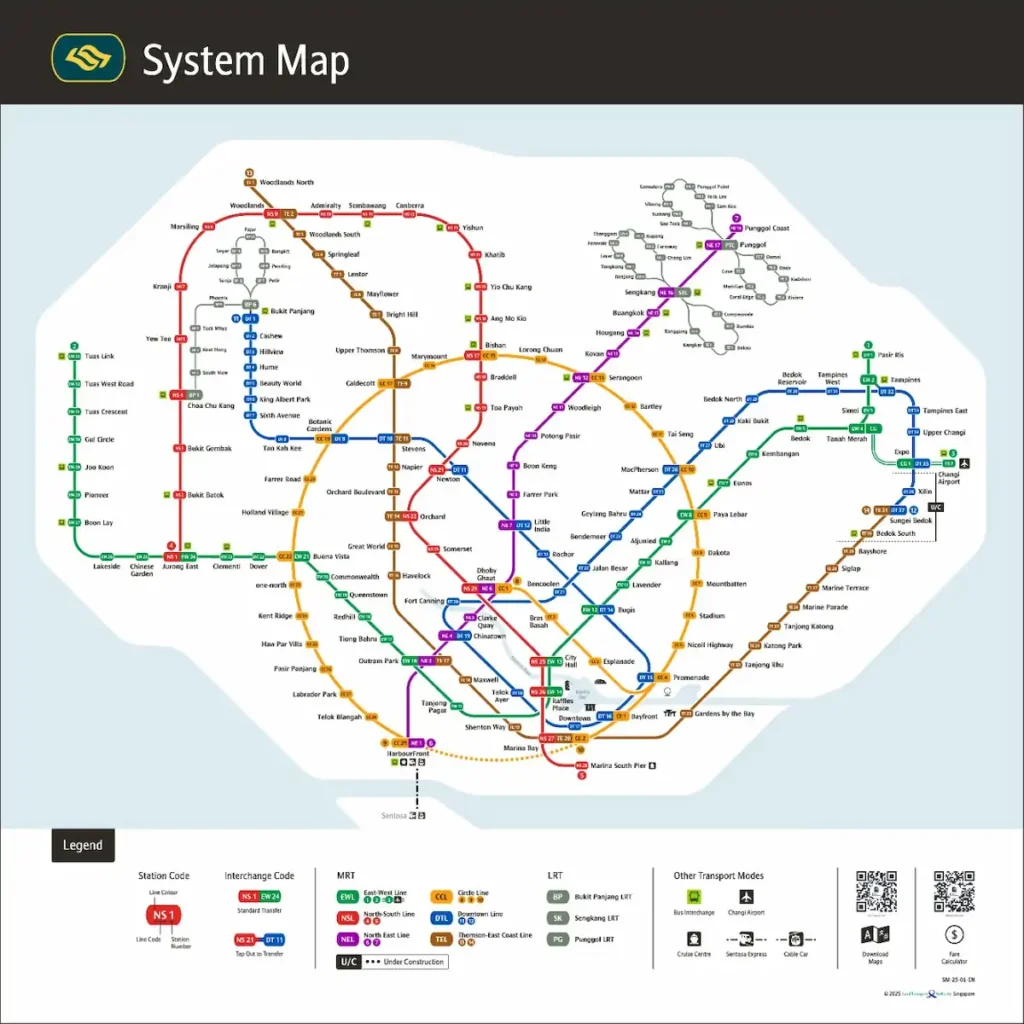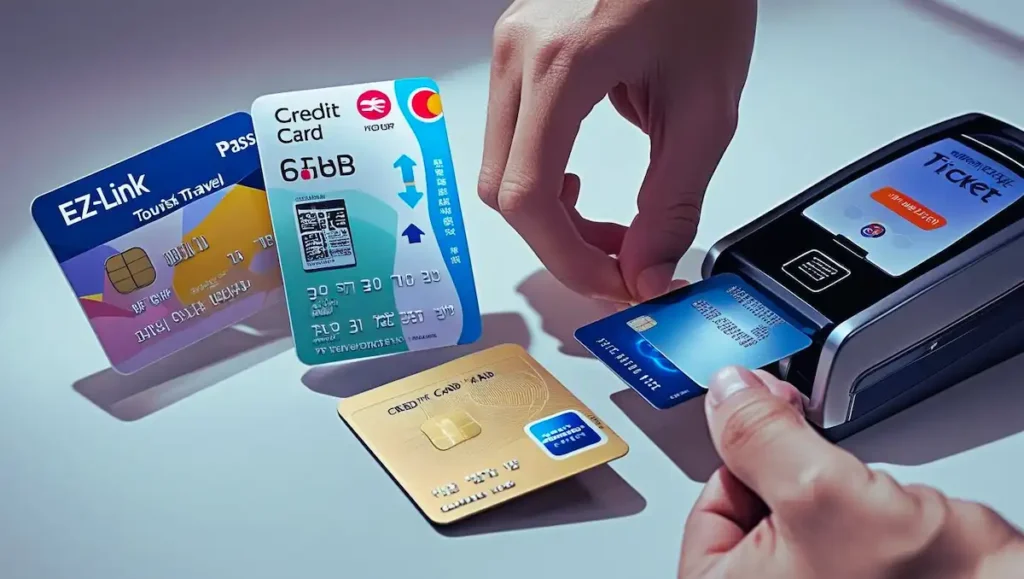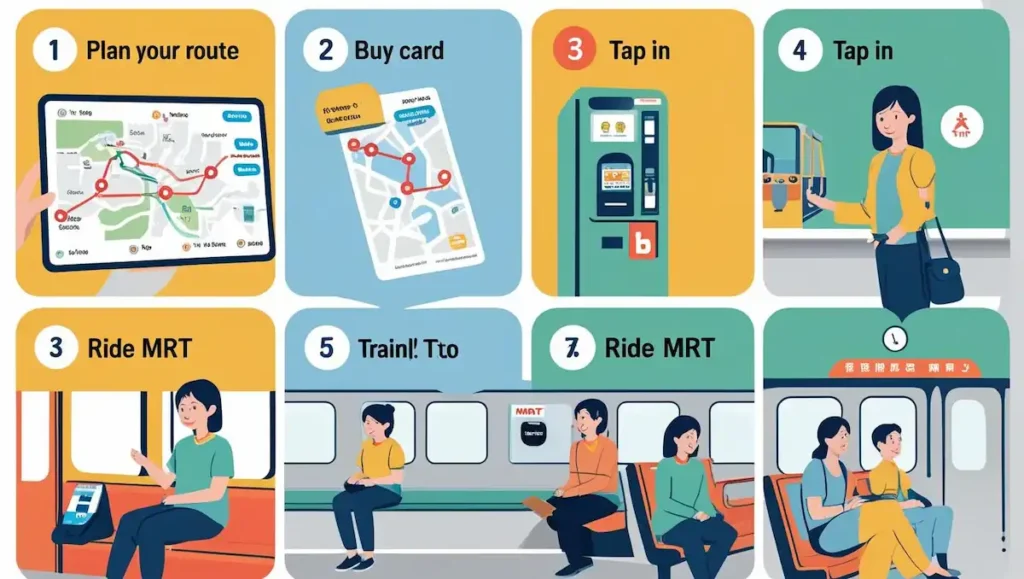Introduction
Feeling overwhelmed by public transport in a new city? If you’re a tourist or a newcomer in Singapore, navigating the MRT (Mass Rapid Transit) system might seem like a daunting task at first. With various payment options, a maze of colored lines on the map, and a set of rules that aren’t always obvious, it’s understandable to feel lost before even stepping on your first train.
But don’t worry you’re not alone. Countless first-time visitors have successfully mastered the MRT, and you can too.
This comprehensive guide is designed to make the process simple and stress-free. Whether you’re heading to Marina Bay Sands, exploring Chinatown, or catching your flight at Changi Airport, this guide will help you understand how to use the MRT confidently and efficiently. You’ll learn everything from understanding the MRT map and payment methods to following rules, transferring lines, and avoiding common pitfalls.
By the end, you’ll be ready to explore Singapore like a local all while saving time, money, and energy.
If you’d rather avoid taxis during costly peak times, you can explore our simple guide on using the MRT in Singapore as a surcharge-free alternative to travel more affordably.
Why Use the Singapore MRT? Benefits for Visitors:
The MRT is one of the most convenient and efficient ways to get around Singapore. Here are several reasons why tourists and new residents often prefer the MRT over taxis, buses, or rideshare services.
1. Extensive Network The MRT network spans almost every major area and attraction in Singapore. Whether you’re visiting Orchard Road for shopping, heading to Sentosa Island for fun, or catching a flight at Changi Airport, there’s likely an MRT station nearby.
2. Efficiency Trains arrive frequently and are usually very punctual. During peak hours, trains may arrive every 2-5 minutes, ensuring that you won’t be waiting long. With minimal delays and fast travel times, the MRT is perfect for those with packed itineraries.
3. Affordability Compared to taxis or ride-hailing apps, MRT fares are significantly lower. A typical ride might cost just over a dollar, depending on the distance. For budget-conscious travelers, this is an excellent way to cut transportation costs.
4. Convenience MRT stations are strategically located near major landmarks, tourist attractions, and residential areas. Many stations have multiple exits that connect directly to malls, streets, or other transport hubs.
5. Ease of Use Once you understand how it works, the MRT is incredibly user-friendly. There are clear signs, frequent announcements, and an intuitive layout that makes navigating the system manageable.
6. Comfort All MRT trains are air-conditioned and well-maintained, offering a comfortable ride, a relief in Singapore’s hot and humid weather.
Understanding the Singapore MRT Map:

In addition to recognizing line colors and interchange stations, here are deeper strategies to master the MRT map:
Know Your Direction MRT trains run in two directions, usually labeled by the terminal station at each end. For example, on the North-South Line (Red), trains move between Marina South Pier and Kranji. Always check the direction based on the last stop.
Using Official Maps At each station, you’ll find a printed MRT map on walls and near ticket machines. These maps are updated regularly. Always verify your line’s coverage, especially during maintenance or expansions.
Using Apps for Real-Time Mapping Apps like Citymapper and MyTransport.SG include interactive MRT maps. They let you click on stations to see service details, identify nearby exits, and even preview your route with walking times.
Look for Exit Diagrams Exit maps at station entrances and platforms show where each exit leads. These maps help you pick the closest exit to your intended destination.
Main MRT Lines and Their Colors
| Line Name | Color | Key Areas Served |
| North-South Line | Red | Orchard, City Hall, Marina Bay, Woodlands |
| East-West Line | Green | Changi Airport, Bugis, Jurong East, Tuas |
| North East Line | Purple | HarbourFront, Clarke Quay, Little India |
| Circle Line | Orange | Esplanade, Serangoon, HarbourFront |
| Downtown Line | Blue | Chinatown, Bugis, Expo |
| Thomson-East Coast Line | Brown | Woodlands, Orchard, Gardens by the Bay |
| Sengkang LRT | Light Blue | Sengkang residential areas |
| Punggol LRT | Pink | Punggol residential areas |
| Bukit Panjang LRT | Grey | Bukit Panjang residential areas |
Planning Your Route Use apps like Google Maps or Citymapper to find the fastest MRT routes. These apps help identify the nearest station, suggest the best train lines, and highlight transfer stations.
Tip: Always check the last train timing if you plan to travel late at night.
Getting Ready: Payment Methods for the MRT:

Singapore offers multiple payment methods for MRT rides, ranging from tourist-specific passes to modern contactless solutions. Here are your options:
1. EZ-Link Card A stored-value card that you tap at the fare gates. It offers slightly cheaper fares and is ideal for frequent rides.
- Where to buy: MRT stations, convenience stores
- Top-up: Machines or apps
- Best for: Visitors staying longer than 3 days
2. Singapore Tourist Pass An unlimited travel card valid for 1-3 days.
- Where to buy: Changi Airport, TransitLink offices
- Pros: Unlimited rides, convenient for short intense visits
- Cons: Not cost-effective for light users
3. Contactless Credit/Debit Cards (SimplyGo) You can tap your Visa, Mastercard, or Amex card directly at the gates.
- Best for: Tourists with eligible cards who want to avoid buying a new card
- Watch out for: Foreign transaction fees
4. Mobile Wallets (Apple Pay, Google Pay) Just tap your phone or smartwatch to pay.
- Best for: Tech-savvy users
- Note: Make sure your device is charged
5. Standard Tickets Single-trip tickets bought at machines.
- Best for: Very infrequent users
- Cons: More expensive, less convenient
Not sure which card to buy? See our guide on where to buy MRT cards for tourists and locals.
Comparison Table
| Payment Method | Pros | Cons | Best For |
| EZ-Link Card | Widely accepted, slightly cheaper | Requires top-up | Long-stay visitors, new residents |
| Singapore Tourist Pass | Unlimited rides | Needs deposit, not for light users | Tourists with packed schedules |
| Contactless Cards | No card needed, convenient | Bank fees may apply | Card holders visiting short-term |
| Mobile Wallets | Convenient, no physical card needed | Needs charged phone | Mobile-first travelers |
| Standard Ticket | Simple for one-time use | Most expensive, time-consuming | Rare/one-time users |
Step-by-Step Guide to Riding the MRT:

Using the MRT is a simple process once you understand each step. This section breaks down the process from planning to exiting.
Step 1: Plan Your Route Use an MRT map or a navigation app to plan your journey. Identify your starting station, the destination, and any transfer stations you may need. These tools also provide fare estimates and train timings.
Step 2: Find the Station Entrance Look for signs with the MRT logo (a stylized M) indicating station entrances. Entrances are often integrated with malls or street-level access points.
Step 3: Tap In Use your payment method (EZ-Link, Tourist Pass, credit card, or mobile wallet) to tap at the fare gates. Make sure the reader beeps and the gate opens.
Step 4: Follow Signs Inside the station, follow the color-coded signage that corresponds to your MRT line. Signs will indicate directions to platforms.
Step 5: Find Your Platform Each platform has digital boards showing the next train’s arrival time and destination. Ensure you’re on the correct side of the platform for your direction.
Step 6: Wait Safely Stand behind the yellow safety line. Let passengers alight before boarding, and allow elderly or disabled individuals priority.
Step 7: Board the Train Enter the train and move inside to make room for others. During peak hours, be mindful of crowding.
Step 8: Monitor Your Journey Announcements and electronic signs in the train will indicate upcoming stations. Get ready to alight one stop before your destination.
Step 9: Prepare to Alight Move near the train doors and wait until the train stops before exiting.
Step 10: Tap Out Use the same payment method to tap out at your destination. This ensures accurate fare calculation.
Step 11: Find Your Exit Follow the ‘Exit’ signs. Each exit is numbered and leads to different streets or landmarks. Check maps in the station to choose the best exit.
Fares and How They Are Calculated:
MRT fares in Singapore are distance-based, which means the longer your journey, the more you pay. However, the system remains affordable compared to other modes of transport.
Distance-Based Fare System: Each trip’s fare is calculated based on the shortest travel distance between the entry and exit stations. This calculation is automatic when you tap in and out using your card or mobile wallet.
Fare Differences by Payment Type: Using an EZ-Link card or contactless card typically gives you lower fares than buying a standard ticket. The savings accumulate significantly if you take multiple rides.
Fare Estimation Tools: You can estimate fares using the Land Transport Authority’s (LTA) fare calculator on their website or apps like Citymapper and Google Maps. These tools help you budget your transport expenses more accurately.
Simplified Fare Guide:
| Distance Range (km) | EZ-Link/Card Fare | Standard Ticket Fare |
| 0 – 3.2 km | ~$0.92 – $1.02 | ~$1.70 |
| 3.3 – 7.2 km | ~$1.12 – $1.32 | ~$2.00 |
| 7.3 – 11.2 km | ~$1.42 – $1.62 | ~$2.30 |
| 11.3 – 15.2 km | ~$1.62 – $1.82 | ~$2.60 |
| 15.3 – 19.2 km | ~$1.82 – $2.02 | ~$2.90 |
| > 19.2 km | ~$2.12+ | ~$3.20+ |
Note: Please note that the fares mentioned are approximate and subject to change. For the most accurate and up-to-date information, it’s best to check the official Land Transport Authority (LTA) website or use journey planner tools before you travel
Key Stations and Transfers:
Navigating between MRT lines can be one of the most confusing parts for new users. Interchange stations are where different lines intersect, allowing passengers to transfer from one line to another. These stations are usually larger and busier, but the signage is clear and abundant.
What is an Interchange Station? An interchange station is where two or more MRT lines cross. Passengers can transfer lines at these points without needing to exit the paid area, making the transfer quick and easy.
Tips for Transferring at Interchange Stations
- Follow the colored signs that represent the line you want to transfer to.
- Some transfers require changing levels via escalators or lifts.
- Be prepared for a short walk within the station complex.
- Re-tapping is generally not required unless you exit and re-enter.
Major Interchange Stations to Know
| Station Name | Interconnecting Lines | Tips for Transferring |
| City Hall | North-South (Red), East-West (Green) | Underground transfer, follow signs for line color |
| Raffles Place | North-South (Red), East-West (Green) | Busy station, similar layout to City Hall |
| Dhoby Ghaut | North-South (Red), North East (Purple), Circle (Orange) | Multi-level interchange, use signs to find correct line |
| Outram Park | East-West (Green), North East (Purple), Thomson-East Coast (Brown) | Major hub with long walkways, signage is reliable |
| Serangoon | North East (Purple), Circle (Orange) | Compact but busy, clear directional signage |
| Marina Bay | North-South (Red), Circle (Orange), Thomson-East Coast (Brown) | Central location, follow signs closely |
| Bugis | East-West (Green), Downtown (Blue) | Straightforward signage, shorter walking distance |
| Botanic Gardens | Circle (Orange), Downtown (Blue) | Easily navigable, not as crowded as others |
These transfer stations are designed for ease of movement but expect crowds, especially during rush hours.
MRT Etiquette and Rules
Singapore’s MRT is known for its cleanliness, efficiency, and polite commuting culture. To maintain this environment, there are clear rules and social etiquette to follow.
Essential MRT Etiquette
- Stand on the Left: On escalators, stand on the left to allow others to pass on the right.
- Queue Orderly: Always line up behind the marked platform lines.
- Let Others Alight First: Wait for all passengers to exit before you board.
- Offer Priority Seats: Reserved seats are meant for elderly, pregnant women, or people with disabilities.
- Keep Volume Down: Use earphones for media and avoid loud conversations.
Prohibited Behaviors
- No Eating or Drinking: Eating or drinking inside trains or stations is banned and can lead to fines.
- No Smoking: Smoking is strictly prohibited in all MRT areas.
- No Flammable/Dangerous Items: These include explosive substances or highly flammable goods.
- No Durians: Due to their strong odor, durians are not allowed in the MRT
Common Fines and Penalties
| Offense | Fine Amount (SGD) |
| Eating/Drinking | $500 |
| Smoking | $1,000 |
| Flammable goods | $5,000 |
| Littering | $1,000 |
Being mindful of these rules not only ensures a pleasant ride for you but also shows respect for local customs and laws. Remember, eating and drinking are not allowed on the MRT, many visitors forget this. Please finish your food and drinks before boarding to keep the trains clean and avoid fines.
Operating Hours and Frequency:
Singapore’s MRT system operates daily, offering extensive coverage from early morning until past midnight. However, operating hours can vary slightly by line and station, so it’s important to plan accordingly.
General Operating Hours
| Day(s) | Typical Operating Hours |
| Monday to Saturday | 5:30 AM to 12:30 AM (next day) |
| Sundays & Public Holidays | 6:00 AM to 12:30 AM (next day) |
Trains do not run 24/7, so if you’re planning a late-night outing, check the last train schedule using official apps or the station’s info boards.
Train Frequency
| Time Slot | Frequency |
| Peak Hours (7–9 AM, 5–7 PM) | Every 2–5 minutes |
| Off-Peak Hours | Every 5–8 minutes |
Note: During public holidays or special events, additional trains may be deployed. Still, it’s always best to confirm timing before traveling.
Addressing Common MRT Problems & How to Fix Them
Even in a well-run system like Singapore’s MRT, occasional issues can occur. Here’s how to tackle them without stress.
Card or Phone Won’t Tap
- Possible Causes: Insufficient balance, poor placement, card interference, or reader malfunction.
- Solutions:
- Try tapping again slowly.
- Ensure your card or phone is separate from other contactless cards.
- Top up the card if the balance is low.
- If still unsuccessful, approach station staff for help.
Missed Your Stop
- Solution:
- Use the opposite direction train to return to your intended stop.
Lost Item on Train or Platform
- What to Do:
- Go to the nearest station control room and report the item.
- Provide a detailed description and time of loss.
Service Disruptions
- Causes: Maintenance, breakdowns, or signal faults.
- Solutions:
- Check the latest updates via station announcements, electronic displays, or the TransitLink app.
Can’t Find the Correct Exit
- Tip: Exit numbers correspond to landmarks or street names.
- Check the exit maps near the fare gates.
By staying calm and knowing your options, most problems become easy to solve.
Tapped Wrongly or Forgot to Tap Out
- Visit the Passenger Service Centre at your destination.
- They can adjust the fare or advise on payment issues.
Low Value on Card and No Cash
- Use mobile payment via app if your card supports it.
- Seek nearby convenience stores for top-up services.
Train Stuck Between Stations
This is rare but usually temporary.
Stay calm and wait for announcements.
Never attempt to open doors or exit on your own.
Confused by Platform Signs?
- Look for large signs overhead with arrows.
- If unclear, ask MRT staff or follow other commuters to common lines.
ant to go deeper? Read how to pay for MRT and buses using EZ-Link, SimplyGo, and mobile wallets
Accessibility on the MRT
Singapore’s MRT system is designed to be accessible for everyone, including travelers with disabilities, senior citizens, and parents with strollers.
Features Supporting Accessibility
- Lifts and Ramps: Available at all MRT stations. Look for wheelchair symbols on station maps and signage.
- Barrier-Free Entrances: Smooth and level access for wheelchairs and strollers.
- Accessible Toilets: Clearly marked within station premises.
- Priority Cabins and Seating: Reserved areas on platforms and trains for passengers with mobility issues.
- Visual and Audio Announcements: In-train systems announce each stop with visuals and voice prompts
Tips for Travelers with Luggage or Strollers
- Use lifts rather than escalators.
- Avoid peak hours to ensure space for your belongings.
- Hold onto handrails and secure bags to avoid them rolling.
Singapore’s thoughtful infrastructure ensures that mobility challenges don’t have to restrict your travel experience.
Using Navigation Apps for MRT Travel
In today’s digital age, navigation apps can significantly enhance your MRT experience, especially if you’re unfamiliar with the system.
Why Use MRT Navigation Apps?
- Route Planning: Easily plot the fastest or most convenient route.
- Live Updates: Receive real-time service announcements or delays.
- Fare Estimates: View approximate costs of your journey.
- Station Info: Locate nearest station entrances, exits, and landmarks.
Recommended Apps
- Google Maps: Reliable, widely used, includes walking directions and timing.
- Citymapper: Excellent for route planning, includes disruption alerts and transit tips.
- MyTransport.SG (by LTA): Government app with comprehensive transport information
Tips for Using Apps Effectively
- Turn on location services for accurate guidance.
- Search for destinations by name or MRT station code.
- Save favorite stations or routes for quick access later.
These apps eliminate the guesswork and are especially helpful when transferring lines or planning for last train timings.
Insider Tips for Riding the MRT Like a Local
If you want to navigate the MRT like a seasoned local, these insider tips can make your journey smoother, faster, and more efficient.
1. Avoid Peak Hours When Possible Singapore’s MRT can get crowded during rush hours—typically from 7:00 to 9:00 AM and 5:00 to 7:00 PM on weekdays. If your schedule is flexible, travel outside these windows to enjoy a more comfortable ride.
2. Use Specific Exits to Reach Attractions Faster Many MRT stations have multiple exits that lead to different areas or landmarks. Knowing the right exit can save you time and unnecessary walking. For example:
- Bayfront Station (CE1/DT16): Exit D leads directly to Gardens by the Bay.
- HarbourFront (NE1/CC29): Use Exit E to access the Sentosa Express at VivoCity.
- Chinatown (NE4/DT19): Exit A brings you right into Pagoda Street.
3. Standing in the Middle of the Train Boarding from the center of the platform usually puts you closer to the train’s doors that open at escalators or station exits.
4. Learning to Navigate Complex Interchanges Interchanges like Dhoby Ghaut or Outram Park can be confusing. Follow the floor markings and overhead signs closely. If lost, look for information counters or ask MRT staff.
5. Don’t Rely Solely on the First Train Sometimes, waiting for the second or third train especially during peak hours, can get you a less crowded carriage.
6. Keep a Backup Payment Option In case your card malfunctions or phone battery dies, having an extra EZ-Link card or backup credit card ensures you’re not stuck.
7. Track Your Travel History Use the SimplyGo app to monitor your transactions if you’re using contactless cards or mobile wallets. This is handy for keeping tabs on expenses or identifying errors.
These small tricks can significantly enhance your experience and reduce potential frustration.
Frequently Asked Questions (FAQs)
How to pay for the MRT in Singapore?
You can pay using single-trip tickets, stored-value cards like the EZ-Link card, or contactless payment methods including debit/credit cards or mobile wallets.
How to pay MRT in Singapore for tourists?
Tourists can buy a Singapore Tourist Pass (unlimited rides for a set period), use a single-trip ticket, or pay with contactless cards or mobile payments.
How to pay MRT?
Pay by purchasing a ticket or MRT card, or by tapping a contactless bank card or mobile wallet at the fare gates.
How do I pay my MRT?
You pay by buying a ticket, using an EZ-Link or NETS FlashPay card, or by tapping your contactless credit/debit card or phone at the gate.
Can I tap my debit card for MRT?
Yes, most international contactless debit cards can be used to tap in and out at MRT fare gates.
How to claim MRT fare?
If you exit without tapping out, or experience a fare dispute, visit a TransitLink office or use the customer service counters to claim or adjust your fare.
How to take MRT to Changi Airport?
Take the East West Line (Green Line) to Tanah Merah station, then transfer to the Changi Airport branch line.
How to find MRT stations near me?
Use Google Maps or the MyTransport.SG app, which shows MRT stations near your current location
What are the MRT lines in Singapore?
Singapore MRT has several lines including East West (Green), North South (Red), Circle (Orange), Downtown (Blue), North East (Purple), and Thomson-East Coast (Brown).
How to check MRT arrival timings in Singapore?
Use the MyTransport.SG app, Google Maps, or check electronic sign boards at stations for real-time train arrivals.
Which card is best for MRT?
The EZ-Link card or NETS FlashPay card are the most popular and convenient for MRT travel
How do you use an MRT card in Singapore?
Tap your MRT card on the card reader at the entry and exit gates to enter and leave the MRT system
How do I use my MRT card?
Simply tap your card on the fare gate sensor before entering and after exiting the station.
Conclusion
Singapore’s MRT system is a world-class public transport network that offers affordability, efficiency, and convenience. As a tourist or new resident, mastering the MRT doesn’t take long with the right guidance and now, you have everything you need.
From understanding the colored lines and tapping in correctly, to choosing the best payment method and avoiding fines, you’re well-equipped to use the MRT with confidence. Whether you’re commuting to work, shopping in Orchard, or catching a plane at Changi Airport, the MRT is your reliable companion.
So go ahead, explore Singapore one station at a time. You’ve got this!

